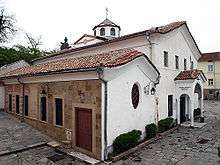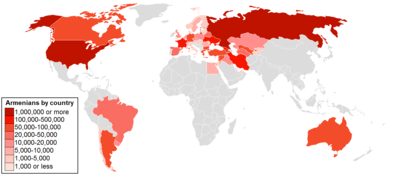Armenians in Bulgaria
Armenians (Bulgarian: арменци, armentsi) are the fifth largest minority, after Russians, in Bulgaria, numbering 6,552 according to the 2011 census,[2] down from 10,832 in 2001, while Armenian organizations estimate up to 22,000.[3] Armenians have lived in the Balkans (including the territory of modern Bulgaria) since no later than the 5th century, when they moved there as part of the Byzantine cavalry. Since then, the Armenians have had a continuous presence in Bulgarian lands and have often played an important part in the history of Bulgaria from early Medieval times until the present.
| Total population | |
|---|---|
| 6,552 (2011), estimation up to 22,000 | |
| Regions with significant populations | |
| Plovdiv Province: 3,140 Varna Province: 2,240 Sofia: 1,672 | |
| Languages | |
| Armenian, Bulgarian, Russian | |
| Related ethnic groups | |
| Armenian diaspora | |
| Part of a series on |
| Armenians |
|---|
 |
| Armenian culture |
|
Architecture · Art Cuisine · Dance · Dress Literature · Music · History |
| By country or region |
|
Armenia · Artsakh See also Nagorno-Karabakh Armenian diaspora Russia · France · India United States · Iran · Georgia Azerbaijan · Argentina · Brazil Lebanon · Syria · Ukraine Poland · Canada · Australia Turkey · Greece · Cyprus Egypt · Singapore · Bangladesh |
| Subgroups |
| Hamshenis · Cherkesogai · Armeno-Tats · Lom people · Hayhurum |
| Religion |
|
Armenian Apostolic · Armenian Catholic Evangelical · Brotherhood · |
| Languages and dialects |
| Armenian: Eastern · Western |
| Persecution |
|
Genocide · Hamidian massacres Adana massacre · Anti-Armenianism Hidden Armenians |
The main centres of the Armenian community in the country are the major cities Plovdiv (3,140 Armenians in Plovdiv Province in 2001), Varna (2,240 in Varna Province), Sofia (1,672) and Burgas (904 in Burgas Province).
The traditional language of the community is Western Armenian, though since education during the Communist period in Bulgaria was in Eastern Armenian, many are also fluent in the latter dialect. Bulgarian, being the official language, is spoken fluently by almost all Armenians in the country.
History
The Armenians that settled between the 6th and the 11th century in the Rhodopes, Thrace and Macedonia were several thousand in number, mostly Paulicians and Tondrakians and had very strong communal ties. They had very strong ties and influenced the Bulgarian sect of the Bogomils and were later assimilated into it, Bulgarianized and later converted to Roman Catholicism (see Roman Catholicism in Bulgaria) or Islam (see Pomaks). The mother of 11th-century Bulgarian tsar Samuil was the daughter of the Armenian king, Ashot II. Maria, the wife of 10th-century Tsar Peter I, was the granddaughter of Byzantine emperor of Armenian origin, Romanos I Lekapenos. Another Byzantine emperor—Basil I, the founder of the Macedonian dynasty and an Armenian from Thrace—spent his early years as a captive in the First Bulgarian Empire in the 9th century.
After both Bulgaria and Armenia were conquered by the Ottoman Empire, many Armenian settlers from Armenia, Crimea, the Polish-Lithuanian Commonwealth and Asia Minor arrived in what is now Bulgaria due to internal migration. Those coming from Armenia were forced to seek a new homeland because of their country's devastation by Arabs, Persians, and Turks.[4] With Bulgaria gaining autonomy in the aftermath of the Russo-Turkish War of 1877-78, many Armenians fled the Ottoman Empire because of the Hamidian massacres in the 1890s and settled in the country, particularly in the major cities of Plovdiv and Varna. In 1878, there were 5,300 Armenians in the Principality of Bulgaria and Eastern Rumelia, and this number increased by almost 20,000 after the Hamidian massacres.[4]
At the time of the Balkan Wars (1912–1913) the Armenians in Bulgaria numbered about 35,000. During this time the legendary Armenian national hero, Andranik Ozanian participated in the Balkan Wars in the Bulgarian army, alongside general Garegin Nzhdeh (another national hero) as a commander of Armenian auxiliary troops. Bulgarian authorities honored Andranik and Nzhdeh with the Order of Bravery.[5] After the events surrounding the Armenian Genocide in the Ottoman Empire (1915–1917) 22,000 additional Armenians sought refuge in Bulgaria during the government of Aleksandar Stamboliyski in 1922.
During the Communist rule of Bulgaria (1945–1989) and the time of the Soviet Union, most of the Armenians returned to their homeland, then the Armenian SSR, but many chose to stay in Bulgaria or emigrate to other countries such as the United States.[4] In the 1990s, after the dissolution of the USSR, the poor economic conditions in Armenia and the military conflicts in the Caucasus caused a number of Armenians to seek a better future in Bulgaria as emigrants or travel through Bulgaria to western Europe or the United States. Since the 1990s the population of Armenians in Bulgaria has continually decreased due to immigration and assimilation.
Many comparisons can be drawn between the struggles for freedom of Bulgaria and Armenia, chiefly based on the similarities between the Bulgarian and Armenian peasants.[6][7]
Culture, religion and media
The Armenians and their historical faith were an inspiration for noted Bulgarian poet Peyo Yavorov to write one of his most recognizable works, the poem Armentsi (Armenians), describing the Armenians as 'forlorn exiles, a miserable fragment; of an ever-brave martyr-people; little children of a troubled slavewoman-mother; and victims of a legendarily great feat':
Изгнаници клети, отломка нищожна
от винаги храбър народ мъченик,
дечица на майка робиня тревожна
и жертви на подвиг чутовно велик –
далеч от родина, в край чужди събрани,
изпити и бледни, в порутен бордей,
те пият, а тънат сърцата им в рани,и пеят, тъй както през сълзи се пей.
Armenians, wretched exiles, tiny splinter
Of their ever valiant, long-suffering kin,
Of restless slave mother tough breed, in the winter –
The victims of their great exploit – or their sin –
From their homeland banished, in foreign land scattered,
Exhausted and pale, in a gloomy saloon,
Now drinking, as their hearts are bleeding, in tatters,
Now singing, through tears, the ballad of doom.(Translated by V.H., 2013)
Three Armenian newspapers are published in Bulgaria: Armentsi issued in Burgas every fortnight with a circulation of 3,500; the weekly Vahan issued in Plovdiv with a circulation of 1,000; and the weekly Erevan issued in Sofia.[3] The Armenian General Benevolent Union (AGBU) publishes a monthly bulletin Parekordzagani Tsayn.
There are a total of ten Armenian Apostolic churches and two chapels in twelve cities, mostly in those urban centres with a significant Armenian population: Aytos, Burgas, Pazardzhik, Russe, Shumen, Sliven, Stara Zagora, Varna and Yambol. All churches are under an eparchy based in Sofia.[3] The Armenian Evangelical Church in Bulgaria is located in Plovdiv.
Notable Bulgarian Armenians
- Haygashod Agasyan, composer
- Armen Ambartsumyan, footballer (goalkeeper) and Armenia international
- Antranik Arabadzhiyan, better known as Astor, illusionist
- Michael Arlen, writer
- Artine Artinian, French literature scholar
- Krikor Azaryan, theatre director
- Yuliya Berberyan, nine times Bulgarian tennis champion in the 1960s and 1970s, tennis coach and UDF deputy
- Raffi Bohosyan, winner of the first series of Bulgarian X Factor
- Steven Derounian, American congressman from New York
- Eduard Eranosyan, footballer and manager
- Magardich Halvadjian, film director and producer
- Vili Kazasyan, composer and conductor
- Kevork Kevorkyan, TV host
- Kirkor Kirkorov, amateur boxer
- Agop Melkonyan, journalist and prolific SciFi author
- Melkon Melkonian, Vice President of the Bulgarian Supreme Court
- Stephen Sacklarian, Artist
- Armen Nazaryan, Greco-Roman wrestler (naturalized)
- Norair Nurikyan, weightlifter
- Dikran Tebeyan, official in the Ministry of Labor and Social Security
- Mari Firkatian, professor of History at the University of Hartford
Partially Armenian Bulgarians
- Magardich Halvadzhiyan, film director and producer
- Philipp Kirkorov, singer, actor and television presenter
- Katerina Maleeva, tennis player
- Magdalena Maleeva, tennis player
- Manuela Maleeva, tennis player
- Alice Panikian, Miss Universe Canada 2006
- Sylvie Vartan, French pop singer and music hall impresario
Footnotes
- "01.03.2001 TO POPULATION BY DISTRICT AND ETHNIC GROUP". Sofia: REPUBLIC OF BULGARIA. NATIONAL STATISTICAL INSTITUTE. 2001. Retrieved 2009-09-07. Cite journal requires
|journal=(help) - "Население по местоживеене, възраст и етническа група" (in Bulgarian). National Statistical Institute. 2011. Archived from the original on 2 June 2012. Retrieved 2012-06-13.
- "Website of the Armenian community in Bulgaria" (in Bulgarian). Retrieved 2006-07-10.
- "Armenians" (in Bulgarian). OMDA.bg. Archived from the original on 21 July 2006. Retrieved 2006-07-10.
- (in Russian) Андраник Озанян: Документы и материалы, Ереван, 1991.
- N. and H. Buxton (1914). Travels and Politics in Armenia. London. pp. 31–32.
- Philips Price, Morgan (1918). War and Revolution in Asiatic Russia. London: Allen and Unwin. p. 31.
References
- Мицева, Евгения (2001). Арменците в България — култура и идентичност (PDF) (in Bulgarian). София: IMIR. ISBN 978-954-8872-34-8. OCLC 50403838. Archived from the original (PDF) on 2007-07-17. Retrieved 2007-06-03.
- Edouard Selian. The language of the Paulicians and Pomaks: http://www.saching.com/Articles/The-Language-of-the-Paulicians-and-Pomaks-17121.html
- (in Bulgarian) Едуард Селян. Коренът "джур" в българска езикова среда. Сп. “Филология”, Изд.: СУ "Св. Кл. Охридски", София, 1983, бр. 12 - 13, с. 137 – 139. (Selian, E. The Root “Jur“ in the Bulgarian Language Environment. Magazine “Philology”. Publisher: Sofia University “St. Kl. Ohridski”, Sofia, 1983, issue 12-13, p. 137-139).
- Peykovska, P. War and Migration in Bulgaria from 1912 to 1926, 2017
- Пейковска, П. Демографски аспекти на миграциите в България, 1912-1944, 2019


